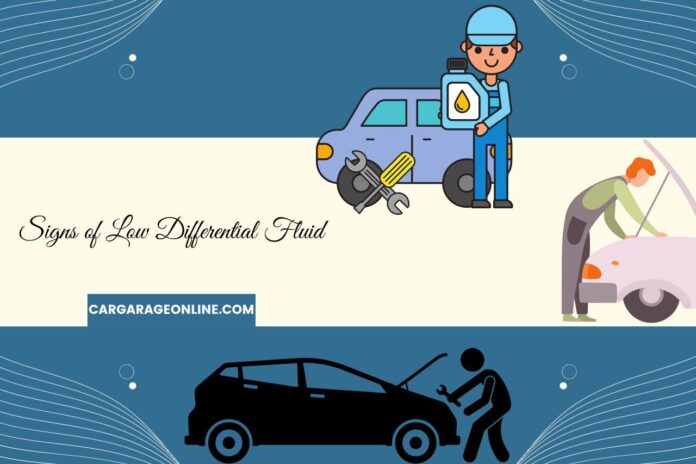There are different kinds of lubricants that car components need. Among them, differential fluid is a must because it is beneficial in many ways. It can protect the car components from wear and tear; thus, you have to maintain a sufficient level of differential fluid all the time. But how do you know when to fill up differential fluid? If you can identify the signs of the low differential fluid, you can refill it without delay. Therefore, today, our article’s aim is to explain the symptoms that your car shows when there is a low level of differential fluid. Let’s begin our discussion!
What is Differential Fluid?
Differential fluid (gear oil) is a lubricant that is used for vehicles in order to prevent premature wear and tear. Basically, the metallic diff components, such as bearings and clutch packs are protected by this lubricant.
Thus, the differential fluid helps to increase the lifespan of those components. And the whole differential can work smoothly with differential fluid.
It usually works under high pressure in order to maintain the lubrication of components and keep the unit cool without letting it overheat.
Moreover, you can experience seamless driving, especially when you take a turn, if you maintain an adequate amount of differential fluid.
What Happens When Differential Fluid is Low?
Differential fluid is thicker when compared to engine oil. In case the differential fluid gets low, there will be a catastrophic damage. As a result, the components, such as the gear and the clutch pack, can break down permanently if you neglect the fluid level.
The reason why, there will be excessive friction caused by metal rubbing. Eventually, you will have to bear costly repairs. In addition, when you drive, you will feel that the wheels vibrate unnecessarily.
The smoke and strange sounds that make the differential will also disturb your ride. Therefore, you will no longer be able to have a smooth ride. Moreover, the car can overheat too, so it is dangerous to keep driving the car with no differential fluid.
Thus, it is always advisable to keep an adequate amount of differential fluid; it does no matter the type of your vehicle.
Signs of Low Differential Fluid
These common symptoms can be identified when the differential fluid level is low in your car.
- Strange Noise – you will hear some strange noises of humming and whining. Those noises will come from your front or rear differential. The noise can change when you accelerate, decelerate and take a corner. When there is a low level of oil, the bearing can worn-out, and it makes those sounds.
- Overheating Differential – when the fluid level is low, the differential can overheat too. Apart from this reason, the wrong oil type also causes overheating issues. Overheating car components can be a threat to your safety.
- Burnt Smell – you will smell burnt oil from your diff area when the differential fluid is low. The reason why, a small amount of oil is unable to lubricate all nooks and cranny parts. Then excessive friction can arise among the metal components. What’s more, the metal in the transmission can start to shave. The wrong type of fluid or expired fluid also can issue such a smell.
- Unnecessary Vibrations – you can feel that the front wheels of your car vibrate unnecessarily, especially in the early mornings and afternoons. This scenario indicates that your differential has started to wear out due to the lack of differential fluid.
These kinds of symptoms can be related to some other issues in your vehicle. Thus, it would be better to visit a professional service centre if you cannot recognize the exact reason.

How Long Can you Go without Changing the Differential Fluid?
As we explained above, differential oil is an important fluid type to keep the good condition of car components, including gears, bearings and so on.
When you fill the right amount of differential fluid, you can drive the vehicle from 30,000 to 50,000 miles without changing the fluid.
It does not need to change differential fluid early, unlike engine oil. According to the usage of each vehicle, the frequency of changing differential fluid can vary. Some vehicles need a fluid change only one time a year, while others do not.
To minimize friction and wear and tear, it is essential to maintain a good amount of differential fluid level.
What does Low Differential Fluid Sound Like?
As we mentioned above, one of the major signs of a low differential fluid is strange noises. But noises are the most common symptom of many car illnesses. Thus, it is worth knowing how low differential fluid sounds like.
The differential can issue sounds such as humming and grinding. Sometimes you can hear sounds like howling or whining as well which come from the front or rear differential.
Check whether there are some changes in noise when you are driving the car. Especially when you accelerate or take corners, those sounds will change. Then you can determine that the problem exists in your differential.
How to Change the Differential Fluid?
- Buy the right differential fluid according to your vehicle model. Moreover, a drain oil pan and a fluid pump will be needed.
- Then, you should run the vehicle for at least 30 minutes. It helps to drain the fluid quickly later.
- After that, park your car in a safe place, engaging its park brake.
- Next, you should crack the vehicle’s filler plug in order to quicken the oil flow.
- Now you can let the old differential fluid drain. Remember to keep a basket underneath the differential.
- Next, the drain plug should be replaced.
- Pump the right amount of fluid using the filler hole.
- Check whether the filler plug has been torqued.
How Much does It Cost to Change the Differential Fluid?
It is possible to change the differential fluid by yourself. In general, the oil will cost $30 to $80. But if you hope to visit a professional service centre, the additional labour cost will be $40 to $70.
Accordingly, the average cost can lie between $70 to $150. However, if the components have worn out due to the lack of fluid, the mechanic will replace them too. Thus, your bill will be increased.
Watch this video,
Video Credits – EasyAutoFix
You May Also Like







![What Is The Best Penetrating Oil For Seized Engine? [Explained] Best Penetrating Oil For Seized Engine](https://cargarageonline.com/wp-content/uploads/2022/07/Best-Penetrating-Oil-For-Seized-Engine-100x70.jpg)